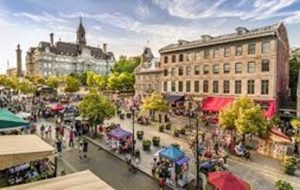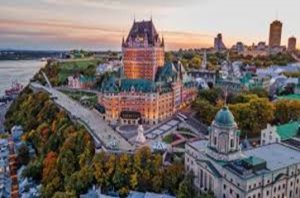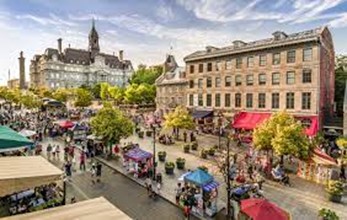OLD MONTERAL, CANADA
OLD MONTERAL, CANADA
Old Montreal, a captivating journey through time, embodies the city’s essence. Cobblestone streets, narrow alleys, and historic structures transport you through 400 years of history. Its charisma lies in architectural beauty, offering delightful bars, enticing restaurants, captivating museums, and unique boutiques, revealing the city’s economic past. It’s not just history; it’s a vibrant canvas of enchanting experiences waiting to be discovered. Come unravel the treasures of this remarkable neighborhood.

Montreal
Quebec, Canada
Montreal, the vibrant heart of Quebec, ranks as Canada’s second most populous city. It reigns over a large portion of the expansive Montreal Island, nestled amid the Hochelaga Archipelago, where the Ottawa and St. Lawrence rivers unite. With a rich history and diverse culture, this city covers 141 square miles, while its metropolitan area stretches across 1,644 square miles, making it a dynamic hub of 1.7 million residents (as of 2021) and over 4.3 million in the greater metropolitan region. Montreal beckons as a captivating and ever-evolving metropolis.

Embracing Montreal’s Weather
Montreal experiences a distinctive continental climate, with the Great Lakes and prevailing westerly winds gently tempering its seasons. In January, temperatures hover around the mid-teens Fahrenheit (-9°C), though windchill can make it feel colder. July brings pleasant averages in the low 70s Fahrenheit (22°C), yet occasional days sizzle above 80s (30°C) with high humidity. Steady breezes and the Great Lakes maintain consistent annual rainfall of around 41 inches (1,050 mm). Winter, however, transforms Montreal into a snowy wonderland, with precipitation exceeding 7 feet (2.2 m), occasionally marred by freezing rain—an occasional reminder of nature’s power, as seen in the memorable blizzard of 1998.
Nurturing Minds: The World of Learning
Montreal’s educational landscape embraces both French- and English-language public schools, in sync with its diverse population. French-speaking institutions prevail, mirroring the city’s Francophone majority, while private schools provide additional options.
In the realm of higher education, Montreal shines as Canada’s academic gem. McGill University, founded in 1821, and Concordia University, formed in 1974, offer predominantly English-language education. On the other hand, the University of Montreal, established in 1876, and the University of Quebec in Montreal, founded in 1968, cater to the city’s French-speaking community. Montreal’s academic mosaic caters to all linguistic and cultural backgrounds.
give me some important question and answers for this topic”OLD MONTERAL, CANADA”.
- Q: What is Old Montreal, and where is it located in Canada?
A: Old Montreal, also known as Vieux-Montréal, is the historic district located in the city of Montreal, Quebec, Canada.
- Q: What makes Old Montreal historically significant?
A: Old Montreal is historically significant as it is one of the oldest urban areas in North America, with a rich history dating back to the 17th century.
- Q: What are some of the notable historical landmarks in Old Montreal?
A: Old Montreal is home to several iconic landmarks, including Notre-Dame Basilica, Old Port of Montreal, Place Jacques-Cartier, and Bonsecours Market.
- Q: How has Old Montreal preserved its historic architecture and charm?
A: Old Montreal has preserved its historic architecture through stringent conservation efforts, with many buildings maintaining their original facades, cobblestone streets, and distinctive charm.
- Q: What role does Notre-Dame Basilica play in Old Montreal’s history and culture?
A: Notre-Dame Basilica is a significant religious and cultural landmark in Old Montreal, known for its stunning Gothic Revival architecture and as the site of important events in Montreal’s history.
- Q: What activities and attractions can visitors explore in Old Montreal?
A: Visitors to Old Montreal can explore a variety of attractions, including art galleries, museums, shops, restaurants, and enjoy activities like horse-drawn carriage rides.
- Q: How is Old Montreal different from other parts of the city?
A: Old Montreal stands out due to its historic character, preserved architecture, and a unique blend of cobblestone streets, historic buildings, and modern amenities.
- Q: Are there events or festivals that take place in Old Montreal throughout the year?
A: Old Montreal hosts various events and festivals throughout the year, including cultural celebrations, music festivals, and seasonal events.
- Q: What is the significance of Old Port of Montreal, and what activities can visitors enjoy along the waterfront?
A: Old Port of Montreal is a historic waterfront area with recreational activities, including boat tours, cycling, and walking along the picturesque waterfront.
- Q: How accessible is Old Montreal, and what transportation options are available for visitors?
A: Old Montreal is easily accessible by public transportation, including the Montreal Metro. Visitors can also explore the area on foot, by bike, or using horse-drawn carriages.
- Q: Are there guided tours available for visitors interested in learning more about the history of Old Montreal?
A: Yes, guided tours are available, providing visitors with insights into the history, architecture, and cultural significance of Old Montreal.
- Q: How has Old Montreal evolved over the years while preserving its historical identity?
A: Old Montreal has evolved by incorporating modern amenities while carefully preserving its historical identity through heritage conservation and adaptive reuse of buildings.
- Q: What is the role of Bonsecours Market in Old Montreal’s cultural and commercial life?
A: Bonsecours Market is a landmark in Old Montreal, serving as a venue for cultural events, exhibitions, and housing shops and restaurants, contributing to the area’s cultural and commercial vibrancy.
- Q: Does Old Montreal have a vibrant culinary scene, and are there specific dishes or restaurants that visitors should try?
A: Yes, Old Montreal has a vibrant culinary scene with a variety of restaurants offering diverse cuisines. Visitors can try local specialties and international dishes in the area.
- Q: Are there any future plans or developments for Old Montreal to enhance its cultural and historical appeal?
A: Information about any upcoming plans or developments in Old Montreal would provide insights into the ongoing efforts to enhance its cultural and historical appeal.

